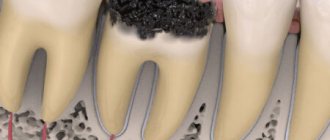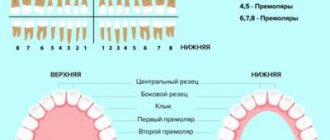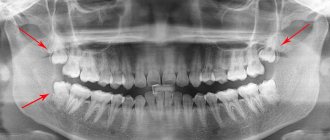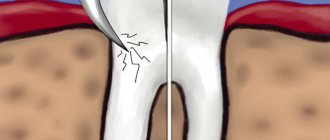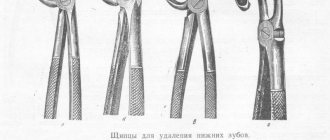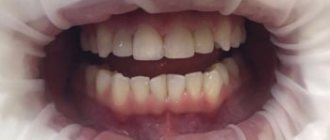What is complex wisdom tooth extraction?
Tooth extraction is called complex if the tooth has several roots, and the operation will require an incision into the soft tissue of the gums and, possibly, the periosteum. Another difference from classic removal is the need to use additional tools (except for forceps and an elevator). The difficulty of performing surgical intervention is due to the difficulty of accessing the extreme elements of the dentition, the root features of the “eights” and the specifics of the clinical case (they are often dystopic or impacted).
Important: you cannot postpone the removal of the defective “eight”. This can lead to suppuration and, as a consequence, to the formation of an abscess and the development of sepsis.
Features of removing tooth fragments
After the walls of the crown are destroyed, the remainder of the root is removed using a special tool. The dentist performs surgery to remove all affected tissue and relieve inflammation. Such removal is complicated by the fact that tooth fragments do not have sufficient strength and can be destroyed during the extraction process. Therefore, the doctor first performs an x-ray (allows you to assess the condition of the root, its location and size, the presence of complications, etc.). Removing the fragments may require soft tissue detachment. When removing the root, gum excision and the use of local antiseptics, anti-inflammatory and other agents can additionally be performed.
Dentospas dentistry recommends performing dental treatment in a timely manner to avoid such complications. If the crown has already been destroyed, make an appointment with our surgeon for an examination and consultation.
Indications and contraindications for surgery
Indications
Surgery is necessary if the wisdom tooth:
- Dystopic (the direction of growth is changed towards adjacent teeth, tongue or cheek)
- Impacted (not fully or not fully erupted)
- Has roots that are too long (this may initiate their penetration into the maxillary sinus or fusion with the jaw)
- Caused inflammation of the “hood” of the gums or periodontal tissue (pericoronitis)
- Caused the formation of a follicular cyst, phlegmon, gumboil or fistula
- Destroyed due to the development of caries or other dental disease
- Caused inflammation of the trigeminal nerve
- Became a source of permanent injury to the oral mucosa
- Interferes with the eruption of other molars with a narrow jaw
Absolute contraindications:
- Malignant tumor in the root zone
- Hemangioma (benign formation)
- Serious chronic cardiovascular problems
Relative (temporary) prohibitions:
- Infectious diseases, including those of the oral mucosa
- Having had a heart attack or stroke
- Taking anticoagulants
- Exacerbation of psychoneurological diseases
- Pregnancy and breastfeeding (except for emergency indications)
What problems may arise in the growth of eights?
- A wisdom tooth may not fully erupt if there is not enough space in the row - such elements are called impacted (fully or partially). The interesting thing is that the figure eight can even look like a full-fledged tooth, but remain inside the bone tissue. Its position can be absolutely anything - vertical, horizontal (rests against the root of its neighbor) or even inverted. In this case, the root system will be near the gums, and the chewing surface, on the contrary, will be below,
- violation of the position, i.e. crooked tooth - in this case it is usually called dystopic,
- if the figure eights are only partially cut through, then a kind of “hood” is formed above them, into which food particles fall. As a result, redness, swelling and acute inflammation of the gums develop, which is accompanied by pain, unpleasant odor,
- the risk of developing caries and gum disease in the area of wisdom teeth is much higher, since hygiene procedures are difficult - that is, the figure eight can erupt immediately with caries.
Important! There is absolutely no need to remove wisdom teeth if they have grown evenly, do not cause pain or displacement of their neighbors, and also in cases where the doctor can reach them if treatment of caries or even pulpitis is required.
Thus, if the eights grow with disturbances, then they lead to bite pathologies, displacement of other teeth, tissue inflammation and very difficult oral hygiene.
Removing the "hood"
Often, difficult eruption of a wisdom tooth leads to inflammation of the gums that cover it (“hood”). This causes enlargement of the lymph nodes, increased temperature, pain when chewing, injury to the gums and, as a result, rapid proliferation of pathogenic bacteria, leading to inevitable suppuration. This situation occurs quite often and is an indication for excision of gum tissue. If the “eight” under the hood is viable and does not cause inconvenience, then it is not removed.
How to understand that wisdom teeth are growing abnormally
Signs or symptoms that indicate problems include the following:
- numbness of the jaw and painful sensations - in this case we can say that the tooth is growing crookedly inside the bone and even injures the jaw nerve,
- sharp pain throughout the jaw, but more so near the base (where the temporomandibular joint is located),
- Above the figure eight, the gum is swollen, moves away from the surface, is red and very painful,
- the lymph nodes become inflamed and increase in size - this indicates the addition of an infectious process,
- the teeth in the row begin to shift - often this may not be noticeable to the person himself, but the doctor will see the changes after performing a panoramic x-ray,
- Due to the lack of space for quality hygiene, a carious cavity appears behind the wisdom teeth or gum disease begins to develop.
Types of anesthesia
Performing surgical interventions is impossible without high-quality anesthesia. During extractions, the following types of anesthesia can be used:
- infiltration anesthesia – provides a local effect. Injected with a syringe into the gum or intraosseously. This is the most common option for dental procedures;
- conductive - has a more powerful effect and is used when operating on particularly complex cases. The injection is carried out to the branches of the trigeminal nerve;
- intraligamentary - used to anesthetize one tooth. The medicine is injected with a syringe into the ligament that holds the tooth in the alveolus.
Expert opinion: Some patients want dental surgery to be performed under general anesthesia. But this type of anesthesia is not as harmless as it is described in advertising articles. It has been proven that it negatively affects the patient's health. An operation to remove teeth, even such complex ones as the “eight”, is not a direct indication for the use of general anesthesia (with rare exceptions). Surgery is painless with the correct selection of local anesthetic. Therefore, you should not strive for general anesthesia and put unnecessary drug burden on the body.
How to care for a hole
Immediately after the procedure, you can apply ice to your cheek to relieve pain and swelling. For severe pain, you can take an analgesic. During the healing period, follow these simple rules:
- Do not rinse your mouth with any solutions unless prescribed by your dentist.
- The tooth socket should not be touched with hands or a toothbrush.
- Avoid physical activity and do not go to the sauna until the wound is completely healed.
- Take medications prescribed by a specialist.
- Do not drink alcohol, as it can cause bleeding.
The surgeon will give you detailed recommendations after the operation. If you notice symptoms of complications, contact your dentist immediately. At our clinic, please contact the doctor on duty for help.
Complications after wisdom tooth removal can occur almost immediately after the operation. Some of them are natural, since removal is a complex surgical procedure, “eights” are located in hard-to-reach places, and they have large roots. But sometimes complications can make themselves felt within six months, and they provoke diseases of the gums, adjacent teeth, bones and even joints. To prevent such problems, you need to know the first signs of pathology and urgently contact an experienced dentist.
Instruments used during surgery
When performing complex extractions, the surgeon may need the following instruments:
- forceps – for extracting a tooth or its elements if they can be grasped. There are different shapes: straight, curved, S-shaped;
- elevator - for loosening entire dental units or their roots in the alveolus;
- excavator - for removing fragments from a deep root fracture;
- scalpel - for cutting soft tissues;
- drill or chisel - for sawing (splitting) large elements of the root or coronal parts with a very dense bone structure.
Stages of surgery
The G8 extraction protocol implies a strict sequence of certain stages:
- diagnosis of the clinical situation. It is carried out by the surgeon when the patient comes for an appointment. First, the doctor conducts a visual examination, determining the extent of damage to the tooth and surrounding tissues. Next - mandatory radiography for an objective assessment of the current condition. The image allows you to clarify the details of the clinical case: the number of roots, possible interweaving, angle of inclination. If necessary, the examination is supplemented by orthopantomography (obtaining an image in 3D format);
- determination of the type of anesthetic and its dose. Questioning the patient about the presence of allergic reactions to any medications;
- injection of an anesthetic drug into the surgical area. The mechanism of action of the anesthetic is as follows: the substance acts on the nerve, it stops transmitting impulses to the brain. As a result, after 5 to 10 minutes a person stops feeling pain in the place where the medicine was injected. After some time (up to 6 hours), it stops working, the transmission of nerve impulses is restored;
- the operation itself. Typically lasts from 30 minutes to one and a half hours. Complex removal involves cutting the gums with a scalpel and stitching them together upon completion of surgical procedures. An incision into the gum tissue allows the surgeon to reach the root system. Then the doctor, using a drill and/or chisel, saws (splits) the molar into several parts and takes it out in separate pieces. If necessary, the roots are taken out in the same way. After all parts are removed, the hole is treated with an antiseptic, and the incision is sutured with surgical threads;
- At this point the operation ends, the surgeon gives the patient recommendations on oral care.
Note: extraction can only be performed by a qualified dental surgeon in a medical institution in compliance with aseptic and antiseptic standards.
Possible complications
Successfully performed surgery and following the doctor’s recommendations minimize the risk of complications. But they are still possible. This:
- severe pain that continues for several days;
- heavy bleeding from the surgical wound;
- inflammatory process (characterized by swelling of the gums, cheeks, and a significant increase in temperature);
- osteomyelitis of the jaw;
- loss of sensitivity in some areas of the face (parasthesia). Possible if the facial nerve is damaged.
Attention! All of the above symptoms are a good reason to immediately consult a doctor. Waiting “for it to resolve on its own” is unacceptable; this can lead to serious consequences, including sepsis.
Why complications arise
Removal of a wisdom tooth performed by an experienced surgeon in a healthy person rarely leads to complications. There may be some discomfort, but it goes away quickly. Serious consequences can occur for various reasons. The most common is improper care. Provoking factors may be:
- Dental diseases. Caries on neighboring teeth, inflammation of the mucous membrane and other diseases can lead to the transfer of pathogenic microflora into the socket. As a result, the wound becomes inflamed.
- Reduced immunity. Removing a wisdom tooth is a surgical procedure. When immunity decreases, recovery takes longer.
- Systemic diseases. Hypertension, blood clotting problems and other cardiovascular diseases can lead to various problems, such as bleeding from the socket.
Medical errors can also lead to complications after wisdom tooth removal:
- Violation of operation regulations.
- Violation of antiseptic rules.
- Not completely removed root, etc.
Removing a wisdom tooth is a complex operation, so you should not trust your health to an inexperienced dentist. Our clinic employs highly qualified surgeons. Therefore, you do not have to worry that serious pathologies will develop due to medical errors.



